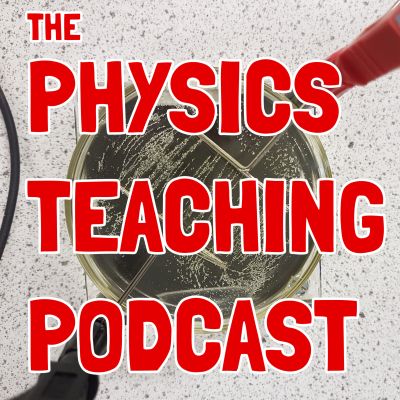We believe that physics teaching is a wonderful thing, but are aware not everyone agrees. In the UK more and more non-specialists are getting the opportunity (welcome or otherwise) to shine a light on peoples misconceptions about the World around them.We started this podcast to provide useful information about how some of the best physics teachers we know teach the subject. Nearly always the answer will be ‘do some practical work’, which we know is essential to grounding understanding as well as being fun to do and making lessons easier to manage.
https://the.physicsteachingpodcast.com
episode 4: Chat(GPT)ting
Everyone has been talking about it for a year or more so high time your finger-on-the-pulse physics teaching nuggets got to grips with ChatGPT (other AIs are available).
To start though, we cantered through another week of physics teaching. Robin was finishing electricity with his year 10 groups, and wondering what others do with those odd bits of the specification that someone up the exam-board food chain (presumably) feels it’s ‘important’ for children to learn. For Robin, this was ‘mains safety’ in electricity which has minimal physics but lots of detail. How do you deal with this? Back when I had to teach biology a lot (don’t ask!) I used to have to teach “Commercial Uses of Plant Hormones” and it took two lessons – so I feel your pain if you are not a physicist. All tips gratefully received – perhaps you’d like to come on and talk about it?
Meanwhile Thomas had been doing great things with inverse-square law investigations, challenging his A-level students to prove inverse-square or not. See the Inverse Square Carousel below for more, but as always, WP adds an inspiring dash of creativity to what could be some pedestrian practical work. If you’ve done anything similar, drop us a line.
We chat ChatGPT and this was where we landed…
Things ChatGPT is good at…- getting past writers block. If the blank page looks vast, try putting a brief into ChatGPT. At the very least it will give you a structure to work with, at best it will give you ideas. Do be careful to rewrite ideas in your own words…
- more text-based problems. Robin always struggles to imagine up testing explanation type (long-answer) questions, but ChatGPT is pretty good at this – but do check carefully as it is not 100% reliable!
- a source of material that students can critique. Thomas used this method to good effect – if ChatGPT spits out a load of garbage, can your students spot the nonsense?
- mindless low-impact admin. Use it to generate standard email responses, box-ticking reports, PM targets and objectives – the sort of things that sap time and have minimal impact.
- Numbers! If you want numerical questions / answers then ChatGPT can be a bit weak / suspect. Again, possibly a source of critique for your students but there may be other AIs that do a better job – let us know! (Mark Whalley mentioned claude.ai which appears to do a better job?)
- Technical diagrams / circuit diagrams etc. Again, there are probably better AI engines for this so do let us know if you have found one.
All technology goes through an initial phase of over-excitement in terms of its transformational potential, but AI does have uses and strengths and Robin has included some examples of a worksheet (with answers) and a set of practical activities in the thermal energy transfer topic so you can see what you make of them. These took about 30 minutes to generate, most of which was getting to grips with the interface and what question to ask (you need to phrase carefully), with remaining time given over to tidying up. You may feel (like Jo) that this represents too much of a time sink, but some will find it helpful I’m sure.
heat-transfer-activitiesDownload Heat-transfer-worksheetDownload Heat-transfer-worksheet-w-ANSWERSDownload Links- Lead absorbtion practical simulation in Excel
- ChatGPT
- Google AI
- Claude AI
Thomas loves this one. No photos of the GM tube and sources, but that is pretty standard.
They are not allowed to touch the magnet (risk assessment) Two pencils to record the angle of rotation Vernier to get the clamp diameter and hence height of lift from circumference – also a 4mm pieve of aluminium to set the height of the clip above the magnet Light – don’t forget risk assessment of the hot bulb vs black paper Sound – stop the beam and just measure amplitude Sound setup Join in!Please share ideas or successes – or indeed questions – on our Facebook Page: https://fb.me/physicstp . You can also message us via our website contact form at the.physicsteachingpodcast.com, Twitter @physicstp, email using the address given in the podcast (if we remember), you could even email us an autio file if you are feeling really keen.
Music- Season 5: Crescents by Ketsa.
- Seasons 3 and 4: Disco Sheik by Podington Bear.
- Seasons 1 and 2: One legged equilibrist polka by Circus Homunculus.
- Occasionally we also use Cantina Rag by Jackson F. Smith.
The music is used under the Attribution-NonCommercial 3.0 International License
Please enable JavaScript to use the contact form.
Your Name Your Email Email Subject Your Message Are you human? Send a copy to your email address? Send Message